Every once in a while we like to stir things up here on the Woodpecker blog and give the floor to a specialist from another company.
Today, that specialist is John Martyn, and the company is Brightest Minds.
Join us to see how to build your ICP and target enterprise leads with cold email. Over to you, John.
ICP: what is it?
In short, an ICP or Ideal Customer Profile describes the type of company that is likely to benefit from your product or service.
Ideally, these companies will have one of the fastest sales cycles with the best customer retention rates while being loyal promoters of your brand.
B2B firms can find prospects more easily using ICPs. This is achieved by restricting prospects options to only those whose description is compatible with an ICP.
Having an ICP gives you the ability to efficiently develop and deliver content to the ideal client.
As a result, both sales and marketing campaigns will be more successful as your message will appeal to the type of leads your organization wants to generate.
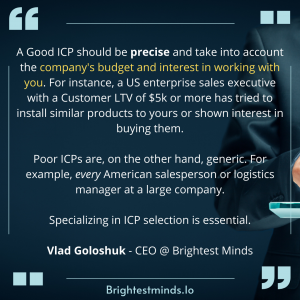
Additionally, the ICP helps you optimize SEO. Depending on where your prospect stands in the buying process, you can create a list of keywords they may search for.
An intelligent marketer will use this data in a targeted ABM campaign on LinkedIn and Facebook triggered by specific prospect actions on a website or in a pipeline.
In this article, we will discuss several ICP strategies used for B2B Marketing to generate leads from companies such as Microsoft, Oracle, etc.
How to build an Ideal Customer Profile?
Start by getting to know those users who love your product more than the average user.
Converting would be much easier if you understood the user’s intent and requirements through understanding users who loved your product.
Don’t worry if you’re just starting out. Base your initial ICP on those of your competitors and continue to update it as you progress.
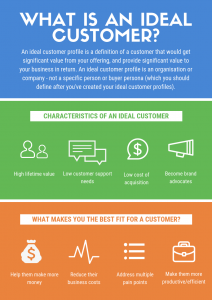
Image source
Keep in mind that the right lead will match your ICP and qualify based on specific characteristics.
An ideal customer profile template includes the following elements:
- Size of the company on average
- Earnings of the company on average
- Perfect location for the business
- Ideal industry or business
As this list is not definitive, you may wish to incorporate other details to pinpoint the right market segments for your product, service, or brand.
When you have assembled the ICP of your choice, write a brief, accurate and comprehensive summary of the entire profile.
Additionally, you can make your ICP more potent by using buyer personas. Buyer personas provide a detailed picture of decision-makers within various organizations and businesses.
ICPs vs. buyer personas
Many people think they are the same, but they are not, and here are some of the reasons:
- The ideal customer profile is extensively used in B2B marketing, while buyer personas are used in B2C and B2B marketing.
- The ideal customer profile describes the target companies that perfectly match your solutions.
- A Buyer persona represents the target characteristics of the decision-makers involved in the buying process.
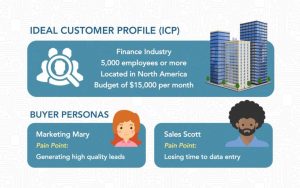 Image source
Image source
In a nutshell, ICP refers to identifying the right company, and buyer personas are the people within that business.
Is there a way to distinguish the ideal customer profile from buyer personas more easily?
There is. The buyer persona is an imaginary character you have created to illustrate the kind of person you want to target: names, jobs, pet dogs, and so on.
The main difference is that buyer personas improve the user experience.
 Image source
Image source ICPs, on the other hand, focus more on determining which customers would most benefit from your product or service. In other words, they view prospects from different perspectives.
It would be best to utilize your ICP at the start of your sales cycle to qualify leads.
Since a sales rep should not waste their time on leads that are unlikely to close based on revenue, company size, or other factors related to ICP.
Sales reps can use ICPs to help them organize correctly matched accounts at the start of the relationship. After that, you can use your buyer personas to decide how to sell to the prospect.
Creating an ICP that stands out
Throughout the sales process, Identity customer profiles require direction.
Interviewing is one way to understand your ICP better. Data you are unlikely to find online may be acquired using it.
Asking existing clients for information is more efficient than searching online. In this way, questions can be revised or amended when creating ICP.
When working on an ICP, you can ask yourself the following questions:
1. Which clients are most rewarding for us?
Assess the prospects you had the most fun working with last year. It may seem uncommon but do it.
Why was working with those prospects so fantastic?
Answering these questions allows you to formulate your ideal client profile.
2. Are your ideal prospects heard?
Can you identify the ICPs’ pain points? What are their challenges? Dreams? Aspirations? – what solutions do they need?
It would be helpful if you put yourself in your ideal client’s shoes and constantly ask whether an ICP makes sense.
Does the content make them feel genuinely heard, especially those you enjoy working with?
They should be able to see themselves when they read your content and say – That’s me!
3. Who will pay for your offering
Follow the money. Marketers should always ask, “Who will pay for my product or service?”?
You may have built a good rapport with an organization’s sales representative, but that individual isn’t the primary target.
A more effective strategy would be to reach out to the decision-makers within the organization, such as Directors (or whoever matches your ICP).
You have now developed an idea of your ideal client (both their hard and soft characteristics). Stay within this target market.
In addition to lead qualification frameworks, consider personality, interests, age, and demographics when building your ICPs.
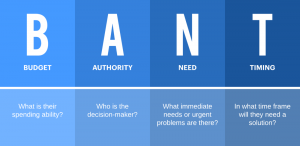 Image source
Image source
BANT is a useful framework for generating leads:
Budget: How much can the potential client afford to spend?
Authority: Does the prospect have the power to make a purchasing decision?
Need: Will your product resolve the prospect’s issue?
Timing: How soon do they need your solution/service?
As an alternative, some businesses prefer to qualify their leads using various approaches, such as the GPCT approach, abbreviated as Goals, Plans, Challenges, and Timeline, respectively.
Leads that have expressed their interest in buying are the BEST – whether they do so directly (by contacting you) or through social media (by commenting on your blog or engaging on your website).
The benefits of account-based marketing (ABM) for cold emailing
Account-based marketing (ABM) is a B2B marketing strategy in which an organization creates customized campaigns for specific accounts rather than trying to reach a broader audience.
The goal of ABM is to generate more leads from high-value accounts that are most likely to convert into customers. One way to implement ABM is through cold emailing.
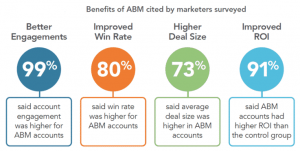
Image source
By targeting specific companies with personalized messages, you can increase the likelihood of getting a response and generating leads.
Enterprise companies are perfect targets for ABM because:
- They often have complex sales cycles
- Require multiple touchpoints before making a purchase decision
However, ABM can be used with any type of customer (not just enterprise leads), and it is an excellent way to get more leads from cold emailing.
How to use ABM to get leads from cold emailing
With ABM, you target specific accounts rather than leads. Businesses can then focus their resources on accounts of enterprise companies that are most likely to convert.
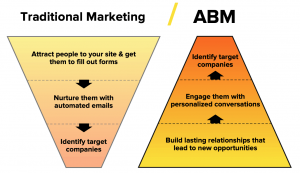 Image source
Image source
To be successful, ABM requires:
- Careful planning and execution.
- Targeting Enterprise Leads requires first identifying the ideal accounts.
- Develop a targeted campaign that speaks directly to the needs of those accounts.
By taking the time to plan and execute an ABM strategy, businesses can significantly improve their chances of generating Enterprise leads from cold emailing.
What’s the best ABM strategy to generate enterprise leads?
Enterprise leads can be challenging to attract and even more challenging to convert. However, many companies have successfully used the ABM approach in their cold email campaigns.
These businesses have taken the time to carefully craft an ABM strategy that targets their ideal customer profile (ICP). They have also developed compelling messages that connect with their target audience.
As a result, they could generate a high volume of high-quality leads. If you are looking to improve your cold email results, consider following their lead and implementing an ABM strategy of your own.
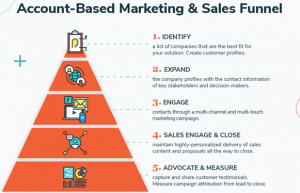 Image source
Image source
The ABM approach allows businesses to target the leads most likely to convert into customers specifically.
Here are 7 tips to always keep in mind to generate enterprise leads:
- When targeting enterprise leads with cold email, it’s important to understand your Ideal Customer Profile (ICP).
- Identifying your ICP allows you to create customized messages that address their specific needs.
- For example, if you’re selling a new software application, you will want to reach out to enterprises that are likely to require your product.
- You can do this by identifying the specific circumstances where they would be interested in your product or service and then tailoring your message to suit their needs.
- Taking the time to plan and implement an ABM strategy specific to your target audience is the key to success.
- You should conduct research to find out what kinds of companies are most likely to require your product and then craft targeted messages that will appeal to them.
- Having a system in place to measure progress and success is also important, so you can make necessary adjustments along the way.
In cold email campaigns for enterprise leads, companies that have used the ABM approach usually have a very clear conception of their ICP.
This strategy exemplifies B2B marketing because it takes a clear-cut approach for each account.
Marketers are starting to embrace it, as it focuses their attention on revenue – mainly through contracts and recurring revenue.
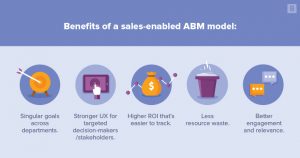 Image source
Image source ABM benefits include:
- Quick sales cycles: Generally, the involvement of multiple stakeholders slows the sales process. It is primarily because the process starts at lower levels and eventually advances to the primary decision-maker.
ABM shortens the sales cycle as each prospect is addressed strategically.
- Boosting ROI: Account-based marketing is measurable and delivers the best ROI of any B2B marketing tactic.
85% of marketers who calculated ROI say ABM delivers a higher return than any other marketing technique.
Remember that an effectively executed ABM strategy will generate high-quality leads, so make sure you get every aspect right.
B2B personalization – what is it?
The purpose of B2B personalization is to customize your advertising, offers, and communication steps to meet the needs of each B2B client.
It involves more intelligent targeting and a better understanding of the B2B customer to make the experience faster and more desirable.
Organizations are focusing on personalization
- According to Forrester, 89% of digital businesses utilize finance and support personalization.
- SmarterHQ reports that 79% of retailers invest in Personalization
- 51% of marketers say personalization is their first preference, according to SmarterHQ
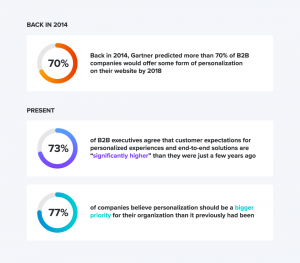 Image source
Image source People’s views on personalization
- In Salesforce’s study, 84% of customers prefer being treated like a “person” rather than a number.
- 70% of customers feel a company’s understanding of their individual requirements affects their loyalty.
Sell your B2B product or service to a Real person on the other end, as a decision-maker might react either positively or negatively to certain cues.
Analyzing your targeted audience can help you give a unique experience that makes a difference in your clients’ lives and increases profits.
Take note of what your customers say (or don’t say), and tailor their experiences accordingly.
How to personalize your B2B marketing in 2 simple steps
In B2B prospecting, the most common mistake is utilizing the same sales strategy for all your clients.
B2B companies should train their sales reps to anticipate and convert their customers’ needs by matching your brand’s offers to them.
Although prospects desire extraordinary experiences, the reality that they experience is usually quite different. Despite this, we have put together some marketing tips to help you:
1) Personalization in cold email:
What makes personalization in emails so important?
Your response rate will double.
SalesLoft’s analysis of thousands of cold emails shows that personalizing your emails can boost your cold email response by 112%.
For a competitive edge, invest in Personalization for your cold emails.
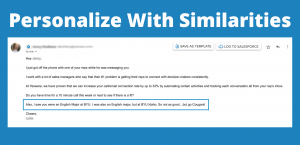 Image source
Image source
Also, personalization has other benefits – such as improving email deliverability.
Open rates will decrease if you always use the same template because spam filters love variety.
2) Enhance B2B experiences through data:
Marketers are rooted in data as the foundation of their actions.
As customer and visitor data continue to grow, choosing the right data for Personalization can be challenging.
Data overload may result in infobesity for marketing departments. An infobesity is a case of data overload and an inability to make decisions accordingly.
The goal of B2B personalization is to add real-time value to a buyer’s decision-making process beyond their needs.
This can be accomplished through factual data, engaging content, fantastic technology, and embracing creativity.
To sum up
To summarize, crafting a unique, targeted action plan can help increase the number of leads you generate.
Finding and engaging Enterprise leads requires the right strategy and resources. The assistance of a good lead generation agency can ease the workload. They will conduct extensive market research to ensure accurate ICP forms among many other duties.
Don’t forget that your work doesn’t end with the creation of the ICP. ICPs must be updated and relevant to changing customer behavior and the market.
Personalization should be your guiding principle when creating content for your leads. Furthermore, it should be an integral part of every sales process step to streamline lead generation.
Are you maintaining an Ideal Customer Profile (ICP)?
How does it impact your marketing?
Suppose you’re struggling to come up with an ICP for your business. You can work with a professional team to generate an Ideal Customer Profile template, save time, and generate qualified leads.
Because personalization is the future of marketing – improving campaigns, boosting conversion rates, and increasing user engagement.

